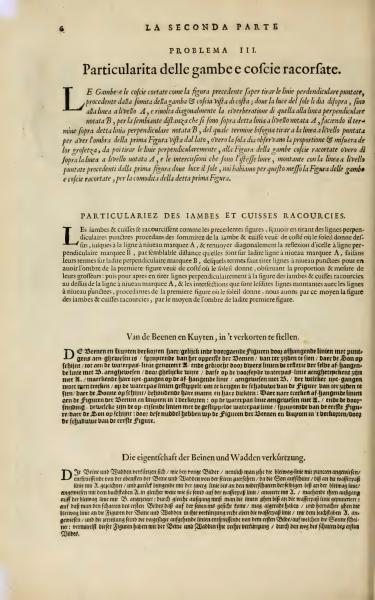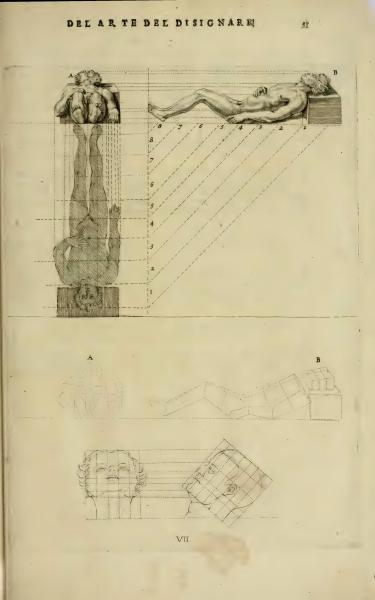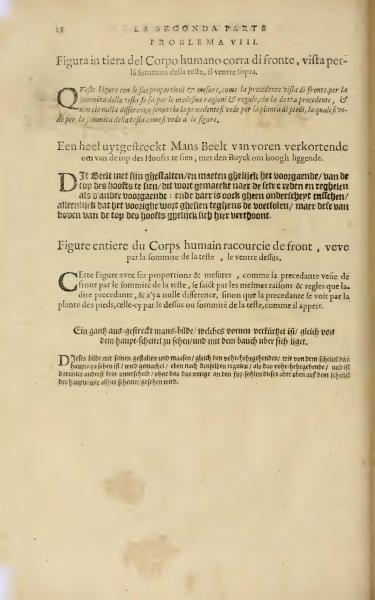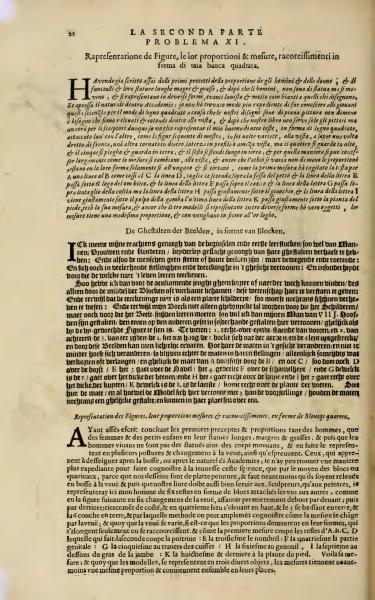| Title | Image | Summary of text |
|---|---|---|
| dePas - First Part - Page 100 |  | |
| dePas - First Part - Page 101 |  | The page contains only the number "12" and a detailed anatomical illustration of a male figure from the back holding a spade. The artwork emphasizes transparency in human musculature and bones, illustrating body structure. This is likely a part of a book teaching anatomical drawing techniques. |
| dePas - First Part - Page 102 |  | |
| dePas - First Part - Page 103 |  | The page number 14 is shown, and it features a detailed illustration of a male figure, likely used for teaching anatomy in art. |
| dePas - First Part - Page 104 |  | The page contains the number "15," likely indicating a page or illustration number. The primary feature of the page is a detailed anatomical drawing of a male figure from behind. |
| dePas - First Part - Page 105 |  | The image shows the number "16" and features a detailed illustration of a male figure in a classic artistic pose. The illustration is likely intended for anatomical study and drawing practice, emphasizing muscle detail and body posture. |
| dePas - First Part - Page 106 |  | The page includes the numeral '17' and features a detailed anatomical drawing of a male figure, showcasing the musculature from a rear view. The drawing is part of a historic book on drawing and painting anatomy. |
| dePas - First Part - Page 107 |  | |
| dePas - First Part - Page 108 |  | The page displays the number '19' and features an anatomical illustration, likely from an art instructional book. This suggests its purpose is to demonstrate human proportions and poses. |
| dePas - First Part - Page 109 |  | The image contains the number "20," possibly indicating a page or diagram number. It is an illustration of the human figure in a detailed anatomical pose from a historic art book. |
| dePas - First Part - Page 110 |  | The image includes the text 'C1', which likely functions as a reference or label. The engraving depicts a detailed study of a male figure's back, suitable for anatomical education. The artistic style and subject support the book's objective of teaching painting and drawing techniques, particularly in understanding human anatomy. |
| dePas - First Part - Page 111 |  | |
| dePas - First Part - Page 112 |  | |
| dePas - First Part - Page 113 |  | This page features an engraving of a seated male figure, focusing on anatomical details. The artwork reflects the style and educational intent of 17th-century art books, likely used for teaching drawing techniques. |
| dePas - First Part - Page 114 |  | |
| dePas - First Part - Page 115 |  | The text titled "The Art of Drawing" consists mainly of letters and numeric labels used within illustrated drawings on the page. The focus is on the techniques and proportions for depicting arms and hands in a structured, artistic manner. It demonstrates the practical application of geometry to create realistic human figures in art. |
| dePas - First Part - Page 116 |  | The text discusses techniques for drawing arms in foreshortened perspective, specifically focusing on proportions and measurements. Instructions are provided for maintaining accuracy by following specific artistic rules, such as using perpendicular and diagonal lines for reference. The explanation is given in multiple languages including Italian, French, Dutch, and German. |
| dePas - First Part - Page 117 |  | The image contains a heading that translates to "Of the Art of Drawing," highlighting a focus on artistic techniques, specifically drawing. |
| dePas - First Part - Page 118 |  | The text details techniques for drawing the shortened proportions of legs and thighs using reference lines and shadows. Instructions are provided in Italian, French, Dutch, and German, emphasizing careful consideration of light and perspective. The methods involve marking and intersecting lines to achieve accurate anatomical proportions. |
| dePas - First Part - Page 119 |  | The text is titled "Of the Art of Drawing" and seems to introduce a section of a historic book. It accompanies anatomical illustrations to aid understanding of human proportions and drawing techniques. |
| dePas - First Part - Page 120 |  | The page discusses the specific techniques of drawing shadows on shortened legs and thighs. It explains how these shadows are represented by diagonal lines crossing the figures and how measurements can be checked marked by line A. This instruction is detailed across various languages, emphasizing specific methods to draw the shadows and intersections for clarity. |
| dePas - First Part - Page 121 |  | The text titled 'On the Art of Drawing' is accompanied by illustrations demonstrating techniques for drawing the human body, focusing on perspective and anatomy. The page number is 4. The illustration provides visual guidance for artists on constructing figures accurately. |
| dePas - First Part - Page 122 |  | The text demonstrates how two figures can be used to show the front and back view of a body. It explains foreshortening of the arms and the use of shadows to create a sense of depth, marked as A and B. The text suggests that these methods adhere to standard drawing techniques to achieve the desired perspective. |
| dePas - First Part - Page 123 |  | The text provides a foundational method for learning how to draw or foreshorten every type of body part according to the rules of perspective. It emphasizes instruction in the geometric art to help artists draw both men and women accurately. The content is aimed at helping art lovers and amateurs improve their skills, using techniques that are scientifically backed by land surveyor's instruction. |
| dePas - First Part - Page 124 |  | The text discusses techniques for drawing foreshortened arms using geometric perspectives and measurements from different views. It emphasizes proportions, shadowing, and the use of perpendicular lines to achieve realistic representations. The explanations include descriptions of how to perceive angles and foreshorten arms effectively in artistic representations. |
| dePas - First Part - Page 125 |  | The text is the title "On the Art of Drawing," indicating the subject of the page. It is part of a historical art instruction book focusing on techniques for drawing figures. |
| dePas - First Part - Page 126 |  | The page discusses the method of drawing two figures, one from the front and the other from the back, using a consistent technique. It emphasizes that the arm positioning should follow the same rule to maintain uniformity, ensuring no difference between this and previous illustrations. The instructions are provided in multiple languages for a broader audience. |
| dePas - First Part - Page 127 |  | The text translates to "On the Art of Drawing," hinting at a treatise focused on illustrating techniques and the principles of drawing. |
| dePas - First Part - Page 128 |  | This text discusses techniques for drawing the human figure with a focus on foreshortening, a method that creates an illusion of depth by compressing dimensions. It emphasizes observing proportions and shadows to accurately depict figures, especially when viewed from specific angles such as from the front or side. The explanation includes instructions on maintaining proportionality while drawing lines to achieve the desired perspective effect. |
| dePas - First Part - Page 129 |  | The text, in Italian, translates to 'On the Art of Drawing.' The page includes diagrams showcasing techniques for drawing proportions of the human body using grid methods. It serves as an instructional guide for artists in achieving accurate representations of human figures in different positions. |
| dePas - First Part - Page 130 |  | The text discusses the depiction of a human body from various perspectives. It emphasizes that the current figure, like the previous one, is viewed from the top of the head for proportional accuracy despite differing viewpoints. The descriptions and proportions remain consistent with earlier depictions, explaining the vantage point as a significant factor in representation. |
| dePas - First Part - Page 131 |  | The image contains the title "Of the Art of Drawing." It is part of an instructional book on drawing techniques, demonstrating figures with precise guides to aid artists in achieving correct proportions and perspectives. |
| dePas - First Part - Page 132 |  | The text discusses the method of drawing human figures from unusual perspectives, focusing on proportions, measurements, and shadow depiction. It describes techniques for shortening parts of the body in representation, ensuring that all components are in balance. Observing specific lines and positions helps visualize the figure's proportions accurately. |
| dePas - First Part - Page 133 |  | The text describes the art of drawing, specifically focusing on using perspective and grids to accurately depict human figures and facial structures. It emphasizes proportional guidelines, labeled with numbers, to aid artists in achieving accurate spatial representation. This instructional text is accompanied by detailed illustrations demonstrating these principles. |
| dePas - First Part - Page 134 |  | The text discusses the technique of foreshortening in drawing the human body, specifically viewing from the top of the head. It explains how lines are used to convert a standard figure into a foreshortened one, focusing on the intersections and perspectives involved. Instructions are repeated in multiple languages on how to achieve this visual effect in art. |
| dePas - First Part - Page 135 |  | The page title translates to "Of the Art of Designing," indicating the focus on teaching principles of design and drawing. The detailed illustrations depict various human body poses with lines and numbers for measurement. These elements suggest a methodical approach to understanding human anatomy for artistic rendering. |
| dePas - First Part - Page 136 |  | The text discusses the representation of figures in art through the use of proportions and measurements, using square blocks as a teaching tool. It explains how these blocks can demonstrate different perspectives and postures of the human form, which is essential for both painters and sculptors. The passage emphasizes the importance of representing living bodies, not just static figures, by using various perspectives and maintaining correct proportions. |
| dePas - First Part - Page 137 |  | The page features diagrams related to the art of designing, specifically focusing on human proportions. It shows structured, geometric drawings of human figures for educational purposes. These illustrations emphasize teaching systematic human anatomy through visual aids. |
| dePas - First Part - Page 138 |  | The text outlines a workshop's handling of male, female, and child portraits, emphasizing the need for different portrayals for various forms and contexts. It provides guidance on how figures maintain their proportions while differing in styles or usages, with references to specific markings for further illustrations. The discussion includes details on correct visualization, instruction, and adaptation of artistic figures. |
| dePas - First Part - Page 139 |  | This page introduces the third part of a treatise on drawing, focusing on the depiction of various postures of nude women. It emphasizes the importance of accurately capturing different body types, such as plump, average, tall, and slender, in life-like proportions. The text is presented in multiple languages and addresses itself to art lovers and learners in the year 1644. |
| dePas - First Part - Page 140 |  | The text discusses the proportion of the human body in art, referencing ancient and modern artists, and particularly Albrecht Dürer's work. It talks about measurement techniques to achieve accurate body proportions using modules or units specific to art. The passage aims to explain basic principles of proportion for achieving beauty and perfection in depictions of the human form. |
| dePas - First Part - Page 141 |  | The text "Del Arte de Designar" translates to "On the Art of Drawing," indicating a focus on drawing skills. The image accompanies this text to illustrate human anatomy for art education. It offers a visual guide for accurately depicting the human body in art. |
| dePas - First Part - Page 142 |  | The passage provides instructions on depicting the female form with specific measurements and proportions compared to men. Women's shoulders are wider, and details are provided on dividing the body into proportional parts from head to feet. It further elaborates on consistent alignment and outlines the proportions in different languages, focusing on artistic rendering of the human body. |
| dePas - First Part - Page 143 |  | |
| dePas - First Part - Page 144 |  | The image features a detailed engraving of a female figure standing beside a draped pedestal. It demonstrates human anatomy for instructional purposes in art. The style is typical of 17th-century drawing guides. |
| dePas - First Part - Page 145 |  | |
| dePas - First Part - Page 146 |  | The image contains a numeral "III" at the bottom, indicating a page or section number. |
| dePas - First Part - Page 147 |  | The image shows a detailed engraving of a nude figure lying on draped fabric, highlighting artistic anatomy and shading techniques. It aligns with the book's theme of drawing and painting the human figure. |
| dePas - First Part - Page 148 |  | The page features a numeral, 'VI,' likely indicating the page number or a section label. It accompanies an illustration of a figure. There is no other text present that provides additional context. |
| dePas - First Part - Page 149 |  | A single Roman numeral, VII, is present, marking the engraving as part of a larger sequence. |
COPYRIGHT © 2024 STUDY DRAWING. ALL RIGHTS RESERVED.